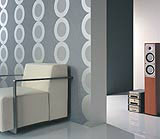Renovating ideas
B&Q’s director of brand and marketing David Roth talks to Hannah Booth about the retailer’s latest design-led ventures and his future in-store plans

Of the 20 wallpapers in B&Q’s new Tate range, launched at 100% Design earlier this year, a handful wouldn’t look out of place in any high-end interiors shop. A few, however, in which morbid blacks, greys, charcoals and metallic silver dominate, would do Adrian Mole proud. You certainly wouldn’t paper a whole room in them.
But the design of the wallpaper, by freelance Judith Townley, is almost irrelevant. The fact that DIY superstore B&Q is producing them at all
is more remarkable.
Its serious dabbling with design doesn’t end here. Following the Tate paint and now wallpaper ranges, B&Q has joined forces with product design postgraduate Matthew White from the Royal College of Art’s Helen Hamlyn Research Centre to create two new power tools, launched on 26 November. ‘It’s a low risk way of dipping a toe into the serious product design arena,’ says B&Q director of brand and marketing David Roth of the collaboration.
Sipping a herbal tea at a particularly rude hour of the morning, he tells me that, whereas the 1980s’ demand for DIY products was fuelled by cheaper products, now it’s driven by design.
‘We didn’t set out to create commercial products [with the HHRC link-up], but I was surprised at how quickly they’ve come to market,’ Roth says. Wheels are already in motion with a second RCA student, Rob Brown, who is designing a set of garden power products.
White proved to be very much of the B&Q mindset: ‘rooted in reality and down to earth, but with a great personality,’ Roth says.
It’s probably too early to tell with Brown – they had their first session last week, but the omens are good.
White’s designs, an electric screwdriver and a hand power sander called Gofer and Sandbug respectively, aim to be in-store in time for Christmas, with an ‘engineered for B&Q’ tagline. They have thrown up a plethora of design challenges for the company.
For a start, they need their own packaging to set them apart from ‘non design-led’ tools. This is being created by B&Q’s in-house marketing and merchandising teams (it has no internal design resource), consultancy Big Idea and White himself. ‘B&Q packaging has traditionally been designed with one thing in mind – transporting the product undamaged from A to B,’ Roth says. Not any more. ‘With [White’s] tools, the packaging must be driven by the proposition of the product, too. As certain products become more aesthetic, the packaging must reflect that,’ he says.
It’s not just packaging design that needs to adapt. The stores themselves need a rethink, too. Roth acknowledges that B&Q is entering new ground and that its giant warehouses need to encourage customers to visit for ‘finishing touches’ products as well as rawl plugs and chipboard.
‘We do need to communicate to people that some of our products are, in fact, design-led. Display is one important way of doing this,’ Roth says. But doing away altogether with the retailer’s warehouses is not the answer, he says.
‘We don’t want to become a department store. We need to retain our solid, no nonsense approach, but certain products need to be better displayed. It’s about finding a balance and discovering how far you can go within a warehouse environment,’ he adds. He is even toying with the idea of room sets. There’s money behind the talk – B&Q’s parent is putting up around £200m for new stores, including a big push in China and Taiwan in particular.
The link up with the Tate was inspired, and several high end brands have approached B&Q with similar propositions. ‘Having the Tate brand on our paints and wallpapers gives customers permission to be bolder than they might otherwise,’ Roth explains. ‘And it gives the Tate an opportunity to persuade people that it is not a lofty, exclusive brand.’
With TV makeover shows still in overdrive, Roth predicts that the turnaround for the design end of DIY will speed up. ‘We’re now operating in a fashion design mindset where trends for colours and finishes come and go. We need to stay ahead of the curve, not play catch up, which means acting in a different way.’ It means a faster turnover of products and ‘learning from fashion designers’ to respond quickly to, or even set, trends.
Makeover programmes have also shown people that much can be achieved with very minor, low cost changes from ‘pick and mixing’ products, Roth says. This means stores must unearth these products from boxes and make them more prominent.
Roth’s recent press comments about his disillusionment with ITV – he is considering taking B&Q’s hefty advertising spend away – prompts the question: is the money being channelled into design instead? ‘We’re not taking money out of television, just to other channels. But our design spend is growing all the time, and we’re increasing our use of design and designers,’ he says.
Roth’s new-found love of design (he has been at B&Q for little over a year) follows a strictly advertising, account management and retail and technology background, and an early spell in the House of Commons. As research assistant to Greville Janner MP, he had his political aspirations ‘knocked out’ of him. ‘I’m not a frustrated MP,’ he laughs. Nor a frustrated marketer, it appears.
David Roth’s CV
1984-87 Research assistant to Greville Janner QC MP
1988 Joins Bates UK ad agency as junior account planner. Becomes strategic director in 1996
1998 Sets up and becomes strategy consultant at Davidroth dot com
2001 Joins B&Q as director of brand and marketing
-
Post a comment



